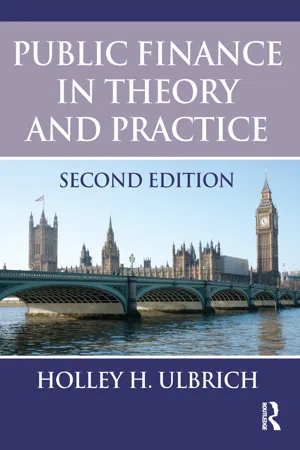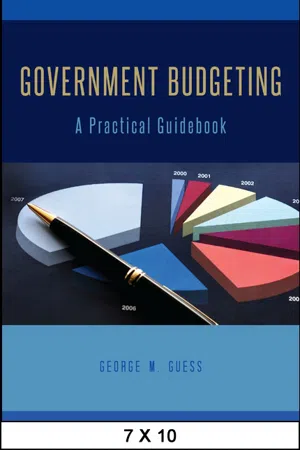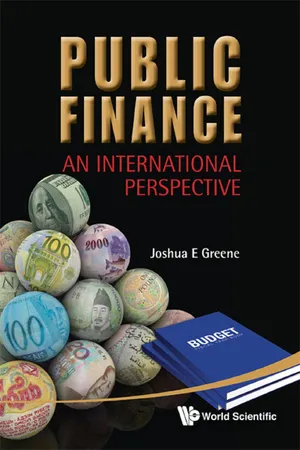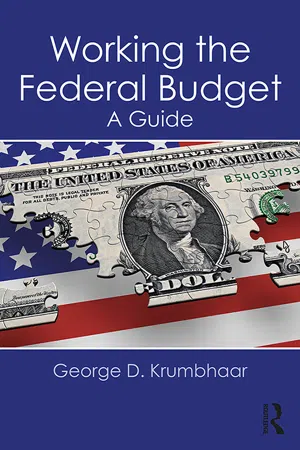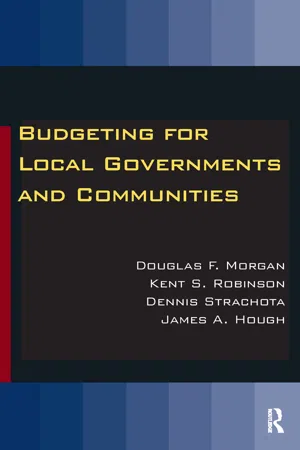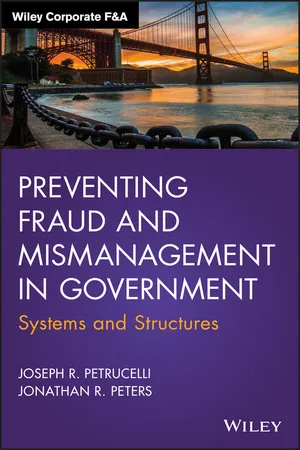Economics
Sources of Revenue for State Government
State governments generate revenue through various sources, including taxes (such as income, sales, and property taxes), fees and charges (like licensing fees and tolls), federal grants, and investment income. These revenues are used to fund public services and infrastructure, such as education, healthcare, transportation, and public safety.
Written by Perlego with AI-assistance
Related key terms
10 Key excerpts on "Sources of Revenue for State Government"
- William Duncombe(Author)
- 2018(Publication Date)
- WSPC(Publisher)
We begin this lecture with a brief description of the tax system in this country. The tax system — reflecting our complicated federalist system — is a complex web of different tax types used by different levels of government and revenue sharing between levels through intergovernmental grants. We will then turn to a brief discussion of revenue forecasting, which is a crucial part of the budgeting process. Finally, the bulk of the lecture will be devoted to a discussion of the criteria typically used to evaluate tax policies and government revenue sources.9.2Overview of the Tax System
As you are well aware, the US has a very diverse system of government, with the federal, state, and local governments each playing an important role in the provision of public goods and services. Although federal, state, and local governments spend similar amounts of the total public budget, they finance these expenditures with significantly different revenue sources. As illustrated in Table 9.1 :1.Federal revenue comes primarily from the personal and corporate income tax and the payroll tax used to finance the social security system (not included in individual income taxes in Table 9.1 ). Although the federal government does use various excise taxes and import duties, it does not employ either a general sales or property tax.2.State revenue comes from a variety of sources. The major source of tax revenue is sales and excise taxes which account for half of state tax revenue. Personal income taxes are the other major source of state tax revenue. State governments do not generally use a property tax. In addition, federal aid is an important source of revenue for state governments (24% of total revenue). For New York, we see that personal income tax is the most important state source of revenue representing 46% of state revenue and almost 60% of state taxes. Consumer taxes (sales taxes) are less important in New York with 17.3% of state revenue and 23% of state taxes. This highlights the diversity across states in their tax systems. For example, four states do not have a general sales tax and seven states do not have a personal income tax.Table 9.1. Percentage distribution of tax revenue for each level of government, FY 2010.a Note: Excludes social insurance contributions.Sources: US Bureau of Census, Governments and Budget of the US Government.Source: Thomas P. DiNapoli, “Citizens Guide 2009: A Pocket Reference to New York State’s Finances,” New York State Comptroller, pg. 2. https://www.osc.state.ny.us/finance/finreports/citizens_guide/citizensguide2009.pdf- Holley Ulbrich(Author)
- 2013(Publication Date)
- Routledge(Publisher)
Part 3 Funding Government Taxes, Fees, and GrantsThe next seven chapters address the revenue side of government: the funds to pay for public programs, the distribution of the burden of paying for government, and the use of revenue instruments as means toward specific policy ends. The primary revenue source for government is taxes. Taxes are the focus of the next five chapters.The first two chapters explore the theory and practice of tax system design. The next three discuss each of the broad categories of taxes—income, sales, and property. The final two chapters in this part examine two other important revenue sources, fees and charges and intergovernmental grants.According to Justice Oliver Wendell Holmes, taxes are the price we pay for a civilized society. That dictum still leaves room to argue over whether the taxes are too high relative to the amount of civilization that citizens want or need or actually receive in return. It does mean that taxes are an inevitable part of living in society. Given the necessity of taxes, it is the economist’s task to provide some guidance in designing a tax system that minimizes the undesired side-effects of collecting them (efficiency) and apportions the burden in some way that addresses the equity concerns raised in Chapter 5 .Although taxes are still the primary form of revenue for governments at all levels, they are not the only source. Fees and charges, discussed in Chapter 16 , are a second and increasingly important way of paying for services that have some advantages in terms of both efficiency and equity. In both unitary and federal systems, intergovernmental grants represent an important supplement to own-source revenues for lower levels of government, a subject addressed in Chapter 17- eBook - ePub
Government Budgeting
A Practical Guidebook
- George M. Guess(Author)
- 2015(Publication Date)
- SUNY Press(Publisher)
Despite these real constraints and the fact that global forecasts depend on aggregation of sub-forecasts for each source, revenue budgets have been historically conservative and quite accurate. That changed in 2007, when it was clear that the baselines and forecasts did not include a recession (Francis, 2012, p. 501). Even in 2008, the recession was predicted to be narrow because it was restricted to housing markets. With hindsight it is clear that housing market exposure was not given proper weight (2012, p. 504). But even those data might not have changed revenue forecasting models since rating agencies had missed the extent of toxic mortgages that had been packaged, securitized, and sold as investment-grade debt. Since bond insurers relied on the same ratings that overlooked subprime mortgage debt, the subsequent collapse resulted in downgrades of municipal debt and higher borrowing costs for cities already strapped by loss of revenues from the recession (Petersen & Ciccarone, 2012, p. 691).The revenue budget consists of estimates for tax, fee, and intergovernmental transfer or aid sources. In volatile economic times, the level of state or county aid will be affected by politics and institutional rules, which may throw off the total estimate of yields. The more a jurisdiction relies on a volatile income source, the greater its effect on the public finances. For example, since it has no income tax (which is usually more stable), the State of Texas relies heavily on sales tax receipts, which fluctuate widely with economic conditions. The state recently discovered that it had underestimated revenues in 2011 by about 28 percent. By law, the comptroller’s revenue estimate ($72.4b forecast versus $101.4b actual) governs expenditure for the next two fiscal years. Texas is one of seven states to still have biennial legislative sessions and a two-year budget based on their decisions (Economist, 2013a). Such uncontrollable variables are a fact of life for budget practitioners, and perhaps the best way to deal with such uncertainty is to maintain open lines of communication with council and legislative liaisons. Such contacts can reduce surprise revenue fluctuations that diminish the accuracy of the planned budget, which leads to service and program disruptions during execution. To allow for course corrections in volatile economic times, revenues may have to be estimated on a rolling basis. It not unusual for cities to experience sudden losses from revenues that did not materialize from higher-tier grants or riders that did not patronize subsidized services such as transit.Property Tax and AssessmentThe property tax is still the most important revenue source for local governments. It provided 45 percent of local own-source revenues and 72 percent of local taxes in 2008 (down from 56 percent and 86 percent respectively in 1968) (Bell, 2012, p. 271). It is flexible and can be used to target growth. Despite weakening of this critical own-source of revenues by antitax legislation from property owners, for instance, California’s Proposition 13, the tax still raised 73.9 percent of total local government revenue and 33.3percent of state and local revenue in 2009 (Mikesell, 2014, p. 488). Wisconsin state law, for instance, prevents localities from raising significant revenues from any other source but the property tax (Milwaukee Plan and Budget - eBook - ePub
Public Finance
An International Perspective
- Joshua E Greene(Author)
- 2011(Publication Date)
- WSPC(Publisher)
Chapter Six: Revenue PolicyAll governments need revenue to fund their operations. In most countries, the revenue comes mainly from taxes : compulsory and unrequited (non-repayable) receipts collected by the government for public purposes. Taxes are levied on a wide variety of items, including household income, corporate and enterprise profits, sales or value added from the production and sale of goods and service, imports, exports, and the value of different kinds of property, including estates and assets transferred by gift or bequest. In addition, governments obtain revenue from non-tax items. These include the profits of public enterprises; central bank profits; income from government-owned property; and administrative fees, charges, and fines. In oil- and mineral producing countries, non-tax revenue from land leases or fees tied to the value of petroleum or minerals extracted from land represent a substantial part of all revenue. Finally, a few national governments, mainly in low-income countries, receive rants : transfers from international institutions or other governments. Grants or transfers are more common among sub-national (provincial, state, regional, or local) governments, which typically receive them from national governments, often to carry out specific programs or in return for fulfilling certain conditions.I. Selected Data on Government RevenueRevenue levels vary considerably from country to country. As indicated in Table 6.1, revenue levels for central governments, as a share of GDP, tend to be higher in advanced (higher-income) economies than in developing and emerging market economies. During the early part of the 2000–09 decade, total revenues averaged about 22 percent of GDP for central governments in developing and emerging market economies and nearly 33 percent of GDP in advanced economies. Most of the difference reflected much higher levels of tax revenue in advanced economies — about 10 percent of GDP more.Table 6.1. Regional averages for central government revenue. - eBook - ePub
The Fiscal Impact Handbook
Estimating Local Costs and Revenues of Land Development
- David Listokin(Author)
- 2017(Publication Date)
- Routledge(Publisher)
This chapter has pointed out the relative importance and geographic concentration of components of local sources of revenue. The fiscal impact analyst must be aware of which sources of revenue are emphasized in the locale where he is working so he can properly project local resources. He must also be aware of the general nature of revenue systems used elsewhere so he can correctly interpret the results of fiscal impact analyses undertaken at several locations. For example, a housing development may have a favorable local cost-revenue impact in an essentially residential area which depends heavily on the real property tax for local revenues. Its impact may be unfavorable, however, in a locality which relies upon a state-levied sales tax for local revenues.EXHIBIT 8-16 RANK ORDER OF STATES IN USING CHARGES AND MISCELLANEOUS REVENUES TO SUPPORT MUNICIPAL OPERATIONS (1972)EXHIBIT 8-17 RANK ORDER OF STATES IN USING CHARGES AND MISCELLANEOUS REVENUES TO SUPPORT SCHOOL DISTRICT OPERATIONS (1972)Exhibits 8-18 , 8-19 , and 8-20 summarize the information presented thus far. Exhibit 8-18 clearly shows that school districts and municipalities fund expenditures differently. School districts rely heavily on intergovernmental transfers (for about 45 percent of total revenues), and 96 percent of that source comes from the state. Municipalities, on the other hand, rely much less on intergovernmental transfers, and a smaller share (80 percent) of these revenues comes directly from the state.Municipalities and school districts differ significantly in their dependence on various categories of own source revenue. School districts depend more heavily on property tax revenues to finance expenditures, but municipalities emphasize sales, income, and other taxes; user charges; and miscellaneous revenue.Exhibit 8-19 - eBook - ePub
Working the Federal Budget
A Guide
- George D. Krumbhaar(Author)
- 2017(Publication Date)
- Routledge(Publisher)
In the current budget debate there is bipartisan support for major revisions in the tax code, even if there is little agreement on the specifics. This section looks at how tax legislation comes to the floor, and why major revisions are hard to come by. Revenue Sources The federal government has two major kinds of income. They consist of: • Government receipts. These include personal income and corporation taxes, customs duties, estate taxes—in fact, anything the government gets through the exercise of its sovereign power. • Offsetting receipts and offsetting collections. These are funds the government gets when it acts more or less like a business selling, say, electricity (TVA), vacations (national park access), and books (the budget). These distinctions are important enough that the money from them shows up in different parts of the budget. Government Receipts The federal government collected approximately $2.2 billion in tax revenues in FY 2015. Figure 9.1 shows that the largest components were personal income taxes, which formed almost one-half of all receipts, and “social insurance taxes and contributions” such as Social Security and unemployment trust fund income. Corporation income taxes formed a large, but significantly smaller share of the total. Federal excise taxes, at three percent of the total, covered such items as federal taxes on alcohol and tobacco. Customs duties, which in the early years of the Republic formed the largest share of federal revenues, now form approximately one percent. Estate and gift taxes, while politically sensitive, were less than one-tenth of one percent of total federal revenues - eBook - ePub
- Douglas Morgan, Kent S. Robinson, Dennis Strachota, James A. Hough(Authors)
- 2017(Publication Date)
- Routledge(Publisher)
Intergovernmental revenues reflect the principles of federalism and local autonomy that are built into the U.S. and state constitutions. Governments at any level—federal, state, or local—may independently raise revenues and may, within their authority, transfer or grant revenues to other levels of government to further the public good. From a budgeting perspective, revenues transferred from one governmental entity to another governmental entity on the same or on a different level are categorized as intergovernmental revenues. Intergovernmental revenues are roughly structured in the following forms:- Direct grants or payments for the performance of a specific service or defined program of services under a voluntary intergovernmental agreement or a contract.
- Reimbursement payments to another level of government to offset the costs of providing statutorily delegated or mandated programs and services, allocated by formula, lump sum, or entitlement.
- Revenue sharing between one level of government and another.3
State governments are the largest source of intergovernmental revenues for local governments. These revenues range from the direct return of shared tax collections to reimbursements granted for the operation of specific programs or services. Federal transfers typically provide an important but smaller source of intergovernmental revenues for cities, towns, and special districts. Federal funds often become the final source of several complementary revenues for a project, thus making it achievable. Local governments must carefully document intergovernmental revenues both for legal and financial compliance purposes, and to enhance transparency and public trust.Direct Grants and Payments
Direct grants and payments for services are voluntary exchanges between governments. These types of grants and payments often exchange the performance of services for payment. For example, a small city might purchase law enforcement services from the local county sheriff’s department. The purchase would be structured under an intergovernmental agreement, similar to a contract that would specify the services provided, staffing and performance criteria, and payment amounts and schedules. The city would make regular payments, and the county sheriff’s office would register those payments as intergovernmental revenues. Programs to make intergovernmental grants may be structured on a competitive or noncompetitive basis, but the final decision to enter into agreement is voluntary. Federal grants in this category would typically include project grants, cooperative agreements, and direct federal payments for a specific use of local services (CFDA 2011 - eBook - ePub
The People's Money
Pensions, Debt, and Government Services
- Michael A. Pagano, Michael A. Pagano(Authors)
- 2019(Publication Date)
- University of Illinois Press(Publisher)
38 . Enterprise charges are for water, sewer, transit, gas, electric, and hospitals. Airports and water ports are other enterprises that should be removed here, but the sources of data used to construct these tables do not show charges for these enterprises separately. In other studies, general revenue excludes charges for water, transit, gas, and electric but includes other enterprises. Total revenue includes charges for all enterprises, and own-source revenue excludes intergovernmental aid.39 . Rebecca Hendrick, “In the Shadow of State Government: Changes in Municipal Spending after Two Recessions,” working paper under review (2018).40 . Hendrick, “In the Shadow of State Government.”41 . Kim, “Limits of Property Taxes and Charges.”42 . Hendrick, “In the Shadow of State Government”; Richard F. Dye and Andrew Reschovsky, “Property Tax Responses to State Aid Cuts in the Recent Fiscal Crisis,” Public Budgeting and Finance 28, no. 2 (2008): 87-111; Erich Cromwell and Keith Ihlanfedt, “Local Government Response to Exogenous Shocks in Revenue Sources: Evidence from Florida,” National Tax Journal 68, no. 2 (2015): 339-76.43 . Kimberly L. Nelson, “Municipal Choices during a Recession: Bounded Rationality and Innovation,” State and Local Government Review 44, no. 1S (2012): 44–63.44 . The effects of recessions on local governments lag for at least one year after the recession starts.45 . Vehicle license fees are included in highway charges because many governments earmark these licenses for roads and transportation.46 . Rebecca Hendrick and Shu Wang, “Use of Special Assessments by Municipal Governments in the Chicago Metropolitan Area: Is Leviathan Tamed?,” Public Budgeting and Finance (2017), https://doi-org.proxy.cc.uic.edu/10.1111/pbaf.12190 .47 . Bird and Tsiopoulos, “User Charges for Public Services,” 51.48 . Bird and Tsiopoulos, “User Charges for Public Services.”49 . Duff, “Benefit Taxes and User Fees.”50 . Bird and Tsiopoulos, “User Charges for Public Services.”51 . Michael E. D. Koenig and Johanna Goforth, “Libraries and the Cost Recovery Imperative: The Emergence of the Issue,” IFLA Journal - eBook - ePub
Fiscal Policy in Underdeveloped Countries
With Special Reference to India
- Raja J. Chelliah(Author)
- 2012(Publication Date)
- Routledge(Publisher)
1 By contrast, in 1956–57 land revenue brought only about 25 per cent of the total tax revenue of all the States. Another tax that has lost some of its former importance is the excise on alcoholic liquor which is within the jurisdiction of the States. As a result of the policy of Prohibition adopted by an increasing number of States from 1937, the revenue from this source has declined in many States.During the period of the relative decline of land revenue and State excise, the commercial taxes have come to the fore, the most important of them being the general sales tax. The emergence of the sales tax as an important source of revenue is an outstanding development in the sphere of State finances. In 1956–57, the total yield from sales taxation for all States was Rs 706·6 million, constituting about one-fifth of their total tax revenue. The sales tax is the main elastic source of revenue possessed by the States and is expected to increase its yield as it comes to be developed in some of the States that have taken to it lately.B. TAXATION OF INCOME AND WEALTHTHE more important taxes on income and wealth are levied by the Union Government. Constitutionally, the States have the power to levy taxes on agricultural income and estate duties in respect of agricultural land. These taxes, however, are not important from the revenue point of view. The taxes on income and wealth that we must consider, therefore, are primarily those levied by the Union Government.The Union Government now levies the following income and capital taxes: personal and company income tax, corporation tax, estate duty, expenditure tax, annual tax on wealth, and gift tax. The gift tax is intended, as in the United States, to supplement the estate duty. The expenditure tax and the annual tax on wealth, on the other hand, are intended to supplement the income tax. Of these taxes, the income tax and the corporation tax have been in existence for a fairly long time. The estate duty was introduced in 1953. The other taxes have been introduced only within the last two years, largely on the recommendation of Mr Kaldor, who was called in as a consultant to the Government of India in 1956. These several taxes are supposed to form an integrated whole and are considered by their advocates as adequate measures of taxation for a developing economy. In what follows, we shall first consider these taxes individually, in turn, and then discuss them as an inter-related system of taxation in the light of the principles evolved in the earlier sections of this book. - eBook - ePub
Preventing Fraud and Mismanagement in Government
Systems and Structures
- Joseph R. Petrucelli, Jonathan R. Peters(Authors)
- 2016(Publication Date)
- Wiley(Publisher)
Tax revenues should be developed for the sole purpose of funding government operations, which, in turn, pay for specific things the government wants to accomplish in line with the policies of a reasonable person's needs. Any imposed tax should maintain a voluntary system that keeps the citizens' freedoms in check and is always completely transparent. It should keep the cost of collection down, encourage economic growth and investment, and reward hard work and savings efforts. It should reduce the required paperwork from the taxpayer. It should encourage exports and not subsidize imports that compete against domestic products. And it should eliminate bureaucracy (red tape) and promote business friendly legislation. In the authors' opinion, there is no greater revenue generator for the government than when public entities create policies that spur job creation. Government needs to set the table for economic growth—via good and reasonable policies—and let the private sector select the proper industries and products to develop. In simplest terms, let the government set the table and have the private sector cook the meal.State and Local Income Taxes
States and local governments may apply income taxes on households and corporations. These taxes range from about 2 to 9 percent on income. These rates vary considerably by state, and this offers an opportunity for firms, in particular, to handle the tax burden through aggressive tax management. These taxes may also alter the competitiveness of a state or region to attract and retain certain types of business. Much of the discussion about the burden of taxation and collection process from the previous federal taxation discussion applies to state income taxes as well.See Appendix Table A.1 for the top ten 2014 state tax rates along with estimated population figures on July 1, 2014. As you can see, the high and low tax brackets vary significantly from state to state, as do the population figures.Sales Taxes
Many states and municipalities apply a sales tax to the cost of goods or services. These taxes are assessed by the final seller of a good or service and charged to the purchaser of the good. Interim sale of goods is not taxed under a general sales tax, but only the final transaction. In the United States, sales taxes are applied to many goods and are generally used by states and local government to provide revenue for the general fund and specific project funding. The rate of taxation varies.
Index pages curate the most relevant extracts from our library of academic textbooks. They’ve been created using an in-house natural language model (NLM), each adding context and meaning to key research topics.

